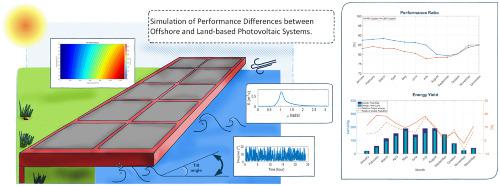当前位置:
X-MOL 学术
›
Prog. Photovoltaics
›
论文详情
Our official English website, www.x-mol.net, welcomes your feedback! (Note: you will need to create a separate account there.)
Simulation of performance differences between offshore and land‐based photovoltaic systems
Progress in Photovoltaics ( IF 6.7 ) Pub Date : 2020-05-11 , DOI: 10.1002/pip.3276 S. Zahra Golroodbari 1 , Wilfried Sark 1
Progress in Photovoltaics ( IF 6.7 ) Pub Date : 2020-05-11 , DOI: 10.1002/pip.3276 S. Zahra Golroodbari 1 , Wilfried Sark 1
Affiliation

|
The purpose of this study is to model, simulate, and compare the performance of a photovoltaics system on land and at sea. To be able to have a fair comparison the effect of sea waves, wind speed and relative humidity are considered in this model. The sea waves are modeled in the frequency domain, using a wave spectrum. The irradiation on a tilted surface for a floating system is calculated considering the tilt angle that is affected by the sea waves. Moreover, the temperature is estimated based on heat transfer theory and the natural cooling system for both floating and land‐based photovoltaic systems. Actual measured weather data from two different locations, one located at Utrecht University campus and the other one on the North Sea, are used to simulate the systems, thus making the comparison possible. Energy yield is calculated for these weather conditions. The results show that the relative annual average output energy is about 12.96% higher at sea compared with land. However, in some months, this relative output energy increases up to 18% higher energy yield at sea.
中文翻译:

模拟海上和陆地光伏系统之间的性能差异
这项研究的目的是对陆地和海上光伏系统的性能进行建模,模拟和比较。为了能够进行公平的比较,在此模型中考虑了海浪,风速和相对湿度的影响。使用波谱在频域中对海浪建模。考虑到海浪影响的倾斜角度,计算出浮动系统在倾斜表面上的照射。此外,温度是基于热传递理论和自然冷却系统估算的,适用于浮式和陆基光伏系统。来自两个不同地点的实际实测气象数据(一个位于乌得勒支大学校区,另一个位于北海)用于模拟系统,从而使比较成为可能。计算出这些天气条件下的能量产量。结果表明,与陆地相比,海上相对年平均输出能量高出约12.96%。但是,在几个月中,这种相对输出能量将海上能源产量提高了18%。
更新日期:2020-05-11
中文翻译:

模拟海上和陆地光伏系统之间的性能差异
这项研究的目的是对陆地和海上光伏系统的性能进行建模,模拟和比较。为了能够进行公平的比较,在此模型中考虑了海浪,风速和相对湿度的影响。使用波谱在频域中对海浪建模。考虑到海浪影响的倾斜角度,计算出浮动系统在倾斜表面上的照射。此外,温度是基于热传递理论和自然冷却系统估算的,适用于浮式和陆基光伏系统。来自两个不同地点的实际实测气象数据(一个位于乌得勒支大学校区,另一个位于北海)用于模拟系统,从而使比较成为可能。计算出这些天气条件下的能量产量。结果表明,与陆地相比,海上相对年平均输出能量高出约12.96%。但是,在几个月中,这种相对输出能量将海上能源产量提高了18%。



























 京公网安备 11010802027423号
京公网安备 11010802027423号